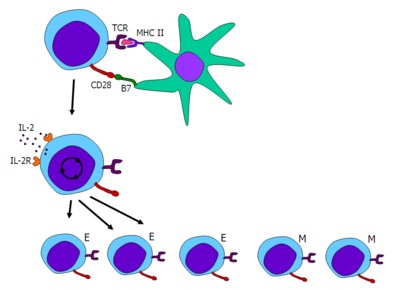
CD4+ Cells
last authored:
Introduction
CD4+ cells, or T helper cells, are T lymphocytes that play a central role in orchestrating the adaptive immune response.
T Helper cells may be distinguished by the presence of a molecule CD4 on their cells surface, giving them the title CD4+ cells.
CD4+ cells are in many ways the orchaestrators of the immune response. After a CD4+ cell recognizes and interacts with antigen presented on a MHC class II molecule, it becomes activated and begins secreting cytokines, or specific immune-associated growth factors. The specific pattern of cytokine expression results in a specific immune response.
CD4+ cells recognize antigen presented in MHC II molecules, initially in the lymph nodes presented by dendritic cells. This leads to CD4+ cell activation.
TH1 cells are involved in the activation of macrophages and cytotoxic T lymphocytes, leading to the killing of viruses and other intracellular pathogens. TH2 cells promote inflammation.
CD4+ Cell Activation
The central event in the generation of humoral and cell-mediated immune repsonses is the activation and clonal expansion of CD4+ cells.
Dendritic cells present antigen on MHC II molecules, which interact with T Cell Receptor on naive CD4+ cells.
TCR signaling, which depends on CD3 and a co-stimulatory signal induced by the CD28-B7 interaction, initiates a cascade of biochemical events that induces proliferation and differentiation into memory and effector cells.
IL-12 is a critical cytokine expressed by antigen presenting cells, driving T cell activation down the Th1 pathway.
This signals entry into the G1 phase of cell cycle and increases IL-2 expression by 100x. Binding of IL-2 to its high affinity receptor, which is also upregulated, induces the naive T cell to proliferate and differentiate.
About 48 hours after activation, the naive T cell enlarges into a blast cell and begins repeated rounds of cell division.
From there, CD4+ cells migrate to the B cell area of lymph nodes, where they induce B cell activation.

Signal Transduction Pathways of Activation
Many genes are expressed following interaction of THcells with antigen.
- Immediate genes are expressed within 30 minutes and include c-Fos, c-Myc, c-Jun, NFAT, and NF-kB.
- Early genes are expressed within 1-2 hours and include IL-2, IL-2R, IL-3, IL-6, IFN-γ
- Late genes are expressed more than 2 days after antigen recognition and include various adhesion molecules
Th1 Cells
Th1 cells develop in response to IL-12 secreted by macrophages. They produce large amounts of IL-2 and IFN-γ, making them important players in cell-mediated immunity through the activation of CTLs and angry macrophages.
Th1 cells are involved in delayed type hypersensitivity, whereby macrophages take up antigen and present to memory Th1 cells, which then go on to activate macrophages.
Th2 cells
TH2 cells are involved in allergic response, tumor response, and granuloma formation.
NK, TH2, or mast cell production of IL-4 induces TH2 production, which cause B cells to produce IgM primarily, but also IgE. Mast cells and eosinophils are thereby produced.
